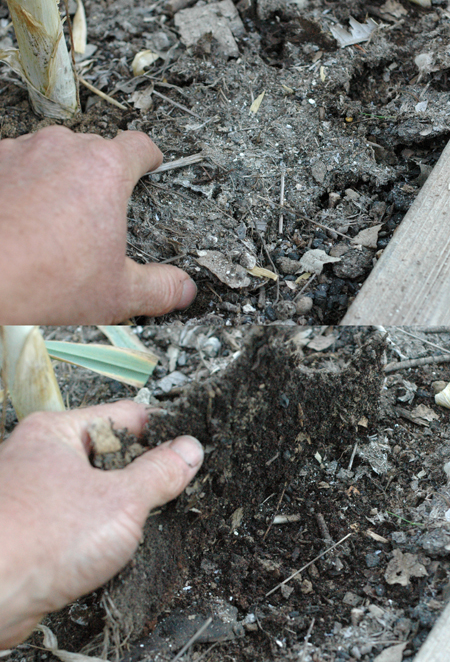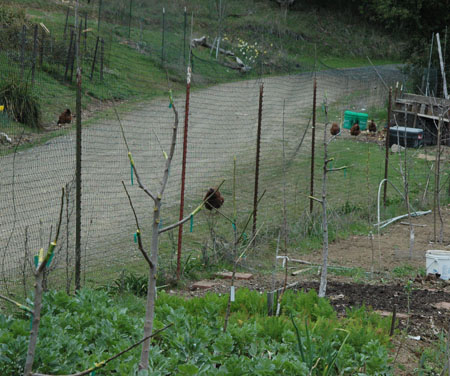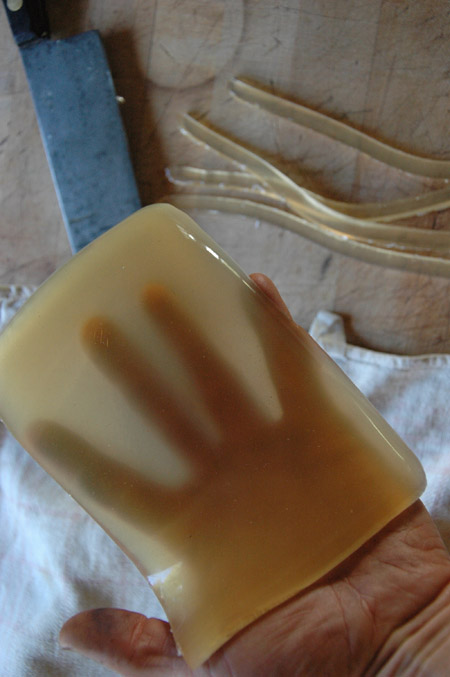Some of you that have been around a while will remember a research piece I did on the use of charcoal as a soil amendment in 19th century America and Europe. I'm always trying to push this information out there, so In this video I read a few of the more interesting passages, which I'll also paste in as text below if you would rather read them.. This is the information that really compelled me to jump into biochar experimentation with both feet. I have quite a few experiments installed now and quite a few more I'd like to do as soon as possible. I have accumulated a pretty good pile of charcoal, so now it's mostly a matter of some planning and digging. Also down the page is a video that I published last Wednesday of peeling a tan oak stump with a few comments about the historic tan bark industry here in California.
Every observing farmer who has been accustomed to raise wheat cannot have failed to notice the luxuriant growth of cereal grain round about the places where charcoal has been burned, even more than thirty or forty years ago. The growing stems of wheat that are produced on such old charcoal-beds are seldom affected with rust; and besides this, the straw is always much stiffer than that which grows where there is not a dressing of charcoal.
& from the same publication
The field was sown with barley in the spring previous ; yield small (eighteen bushels per acre). I turned in the stubble the last week in August, harrowed it over, then took about eighteen bushels charcoal crushed fine, and top-dressed a strip through the middle of the acre over about one-third of its length; I then sowed on my wheat broadcast and harrowed it over twice. The result was, the heads when ripe were at least twice as long as where no coal was put on. I harvested all together; the yield was forty-three bushels. I think by applying about fifty bushels of coal to the acre as a top-dressing, made fine by grinding in a common bark mill, it would increase the yield at least four hundred per cent., if the soil is poor.
The American wheat culturist: 1868
By keeping the surface of the earth well stirred, no crops appear to suffer by drought that are manured by charrings, but continue in the most vigorous health throughout the season, never suffering materially by either drought or moisture”.
“A Dictionary Of Modern Gardening” 1847
In the midst of the disastrous drouth of last summer, while crossing a field in Moriah, occupied by Mr. Richmond, in pursuit of some Durham cattle I wished to examine, I observed a lot with its surface deeply and singularly blackened. -Upon inspection I found it thickly strewn with pulverized charcoal. The field presented a rich verdure, strongly contrasting with the parched and blighted aspect of the adjacent country.
The following detail of this experiment, supplied at my request, attests the value of this material as a fertilizing principle. “The soil is loamy. The charcoal was applied on four acres of dry land, and one acre of moist soil, by top-dressing. The amount used was about one thousand bushels to the acre, spread on so as to make the surface look black, but not to incumber or obstruct vegetation. It was applied in September and October, 1850, at an expense by contract, of forty dollars. It was procured at a furnace, from a mass of pulverised charcoal left as useless, and was drawn one mile and a half. The effect was immediate. The grass freshened, and continued green and luxuriant after the surrounding fields were blackened by the early frosts. Although the last season had been so unfavorable for vegetation, Mr. Richmond realized one-third more than the ordinary yield of hay, and sufficient to repay the whole outlay. He thinks that he cut nearly double the quantity of grass upon this lot, that he did upon any similar meadow on his farm, and that the quantity of the hay is improved.”
“I began the use of it in the year 1846, and first employed it as a top-dressing on a strong clay soil, which was plowed in the fall of 1845. I spread on about fifteen wagon loads of the dust to the acre, after the wheat had been sowed and harrowed one way. I was surprised to find my crop a heavy one, compared with my neighbor’s, raised on the same kind of land. The wheat was of better quality and yielded four or five bushels extra to the acre. I have since used it on similar land, sometimes mixed with barn-yard manure, and sometimes alone, but always as a top-dressing, usually on land seeded for meadow. ‘ The results were always the most favorable. I find my land, thus seeded, produces more than an average crop of hay and always of the finest quality.
“I have also used the dust on loamy and interval land, with the potato crop. During the series of years in which the rot almost ruined the potato crop, I scarcely lost any potatoes from that cause, and supposed it was owing to the coal dust I used. My manner has been to drop the seed and cover it with a small shovel-full of the dust, and then cover with earth. In this way I have used all the coal dust I have been able to save from the coal consumed in a forge of five fires, and which amounts to about 250 loads per year.”
In the colder regions of the Adirondacks, charcoal dust has been used with great advantage. The note of Mr. Ralph presents the experiment in tho following language: “As a top-dressing for meadows, charcoal dust and the accumulation of ashes and burnt earth left on old charcoal pit bottoms have been used here with remarkable results, and I judge from the trials which have been made, that this application has added at least one-third to the hay crop, where it has been used. It was remarked during the past very dry season, when vegetation was almost burnt up by the long continued drouth, that those fields which had been dressed with this substance were easily distinguished by the rich green color of their herbage.”
The cultivator, 1853
“NEW” FERTILIZER FOR GRAPES. Our impression is that the benefit to be derived from the use of chopped up cuttings has been greatly over-rated. We tried the plan once, selecting out the smaller shoots and cutting them up with a straw cutter, while the larger we cut with a small hatchet. We applied the prunings of ten vines to the roots of five, and then we invested the amount which we thought we ought to have for our labor, in charcoal which we applied to the remaining five. We thought the charcoal produced the best results.
Since that time we have disposed of our prunings of all kinds by converting them into charcoal and at the same time burning with them a quantity of heavy clay. The greatest difficulty is to make the heap sufficiently compact to allow it to be covered conveniently. This we accomplish by means of a few stout hooked stakes. After all the rubbish from the fall, winter and spring prunings, has been collected together, we lay a few stout branches or poles on the top. These poles are then pegged down by means of two or three hooked sticks applied to each pole, and in this way the mass is rendered so compact that it is easily covered with sods and similar matter. The heap after being kindled is allowed to smoulder away, more earth being thrown on as the fire progresses. Several days generally elapse before the work is finished,
but at the end of that time we find ourselves in possession of several tons of material of the very best kind for fertilizing vines or any kind of fruit trees. It consists of a mixture of ashes, charcoal and burned clay, and our present opinion Is that there are no better fertilizers for fruit trees, and especially grape vines and peach trees, than just these three articles.
Country gentleman, Volume 33
1869
his trial on a field of four acres with potatoes in 1847, was very remarkable. They were planted in ridges, or, as termed here, ‘lazy beds;’ one-half the field manured with farm-yard manure, the other with peat charcoal only, about a handful thrown on each seed. The result was more than a double crop from the charcoal; and he informed me that he was himself so astonished at the fact, that he requested Lord Donegal to see and vouch it. At my suggestion he planted oats the next year On the whole field without any further manure, and he assured me the increase on that portion manured with charcoal was nearly in the same, ratio as the potatoes. In February last he planted a large field in drills, manured as usual, not then having charcoal; but in. April he got some, and, before the potatoes being earthed, he top-dressed a few yards at the foot of all the drills as far as he had charcoal. He authorizes me to state that the result was not only very nearly a double crop, but that there was not a taint in one of them, while all the rest of the field was more or less diseased.
I must tell you his reply to my inquiry as to his experience of its value for grass land. He said,1 Nothing can exceed it; and there is little or no labour in using it.’ My friend Fenwick swears by it, and he declares he will write his name on the best grass in the country with black charcoal, and it will be the greenest part of the field in ten days.”
The Plough, the loom, and the anvil, Volume 2
1849
Comparative Merits of Charcoal and Barn-yard Manure as Fertilizers.
In the year 1788, my father purchased and removed upon the tract of land in Hanover township, Morris county, N. J. The land, owing to the bad system of cultivation then prevailing, was completely exhausted, and the buildings and fences in a state of dilapidation. The foundation of the barn was buried several feet beneath a pile of manure, the accumulation of years: little or none ever having been removed upon the lands. Even the cellar, beneath the farm-house, was half filled with the dung of sheep and other animals, which had been sheltered in it. The former occupant of the farm had abandoned it on account of its supposed sterility
The barn, before referred to, was removed to another situation soon after its foundation was uncovered, by the removal of the manure to the exhausted fields; and its site,
owing to the new arrangements of the farm, became the centre of one of its enclosures. During the seventeen years which I afterwards remained upon the farm, the spot could easily be found by the luxuriousness of the grass, or other crops growing thereon; though the abatement in its fertility was evident and rapid. On revisiting the neighbourhood in the autumn of 1817, I carefully examined the corn crops then standing upon the spot, and was unable to discover the slightest difference in the growth or product, upon that and other parts of the field. This was about twenty-eight years after the removal of the barn.
Upon the same farm and upon soil every way inferior, were the remains of several pit-bottoms, where charcoal had been burned before the recollection of any person now in the vicinity, and most probably, judging from appearances, between the years 1760-70. These pit-bottoms were always clothed, when in pasture, with a luxuriant covering of grass, and when brought under tillage, with heavy crops of grain. Eleven years ago I pointed out these facts to the present occupant, and his observations since, coincide with my own, previously made; that they retain their fertility, very little impaired, a period probably of about seventy or eighty, certainly not less than sixty-five or seventy years.
Here then is an excellent opportunity of observing the comparative value of charcoal and barn-yard manures, as a fertilizer of lands. The former has not, after at least sixty or seventy years exposure, exhausted its powers of production, while the latter lost its influence entirely in twenty-eight years, and most probably in much less time.
I have since had many opportunities of’ observing the effects of charcoal left in pitbottoms, upon vegetation, one of which only,. I will relate. The last season, in the northern part of Ohio, was one of uncommon frost and drought . In May, the wheat fields, when promising a luxuriant crop, were cut off by frost;—especially in the valleys, and very much injured in the high lands—which was succeeded by the most severe drought ever experienced in the West. The moiety which escaped both these scourges, was afterwards very much injured by rust. Near the village of Canton, upon a farm on high ground, which had been mostly cleared of its timber by its conversion into charcoal, it was observed that upon the old pit-bottoms, the wheat grew very luxuriantly—was clear of rust—and had ripened plump in the berry; while in the adjacent parts of the field it was short in growth, the stem blackened with rust, and the berry light and shriveled..
The Farmers’ cabinet, and American herd-book, Volume 11 1847
CHARCOAL AS A FERTILIZER.
For two years past I have used some fifty loads each season of refuse charcoal, and being fully convinced that it pays, I wish to recommend it to my brother farmers. I have tried it on grass, corn and potatoes—hare tried it alone and in the compost heap, and in all situations it has proved faithful to its trust. As a top dressing for grass, it gives a green color and luxuriant growth.. Applied to half an acre of early potatoes the last summer, the yield was 75 bushels of as fine healthy potatoes as could be desired, that sold readily for one dollar per bushel, and yielded the best profit of anything raised on the farm.
..It absorbs from the air those gasses offensive to the nostrils, but the main food of plants. And this it will do, not once only, or for one season, but very possibly for a century. Where an old coal-pit has been burnt, the land never seems to wear out, and the first settlers point to the coal bottoms that are fifty years old, still by their exuberant vegetation marking well the spot where the wood was converted into coal.
The New Jersey Farmer Vol. II, No. 1, September 1856
CHARCOAL AS A FERTILIZER.
It will be recollected by our readers, that in our last two volumes we have published several able papers upon the virtues of charcoal as a fertilizer of the soil, and of its supposed efficacy in the preservation of wheat from rust. One of these papers, by Judge Hepburn, particularly points out cases in which lands which had been dressed by charcoal had grown wheat free from rust, when wheat grown on other lands, contiguous, which had not been so treated, had suffered greatly from that cause. We allude to these circumstances now, with a view of introducing the subjoined paragraph to the notice of our readers ; by which it will be seen, that in France the same virtues have been ascribed to charcoal as in our own country.
We have been astonished at the enormous increase of the wheat crop in France within the last eight or ten years, and have devoted some attention to the investigation of the subject. It appears that charcoal—an article that can be obtained here for a tithe of its cost in France—has been extensively used, and with marked effect, in fertilizing the wheat lands in that kingdom. A correspondent of the New Farmers’ Journal, an English print, states that during a sojourn in one of the central departments of France he learned that some of the most productive farms were originally very sterile; but that for a number of years their proprietors had given them a light dressing of charcoal, which had resulted in a large yield of wheat of excellent quality. Since his return to England he has tried the experiment upon his own lands with the same happy effect. The charcoal should be well pulverized, and sown like lime, after a rain or in a still, damp day. Even in England, the writer says, “the expense is a mere trifle, in comparison with the permanent improvement effected, which on grass is truly wonderful.”— He states one other very important result from its liberal use. “I am quite satisfied that by using charcoal in the way described rust in wheat will be entirely prevented; for I have found in two adjoining fields, one of which was coaled and the other manured with farm-yard dung, the latter was greatly injured by rust, while that growing in the other was perfectly free from it.”—Buffalo Commercial Advertiser.
Southern planter, Volume 3 1843
ln striking cuttinps or potting plants, fine charcoal is a valuable substitute for sand, plants rooting in it with great certainty. Plants will flourish in powdered charcoal alone with considerable vigor, and, added to the other materials used in potting, it is found greatly to promote healthy growth in most plants.)
Fruit recorder and cottage gardener 1875
there are two features connected with its use which have always commended it to my favor. One is its mechanical effects upon the soil, rendering it more open and friable, and consequently more easily worked, and more open to the action of the atmosphere. The other is the warming effect produced where it is applied in any considerable quantity. A dark soil, we all know, has the power to a greater extent of absorbing heat than a light-colored one. This, in many locations, is a great desideratum. Many plants which it is desirable to grow, but which, for the want of a sufficiently warm soil, is next to impossible, may be cultivated by the use of charcoal.... In gardens, therefore, I esteem it highly, and have found it, for the purposes briefly named above, most excellent
The American farmer: 1861
Charcoal is undoubtedly a powerful fertilizer, and one of great duration, as is shown by the continued fertility of places where the aboriginal inhabitants of New England built their camp-fires more than two hundred years ago, while nothing peculiar to those spots can be discovered beyond the admixture of large quantities of charcoal and clam-shells with the soil.
Annual report of the Commissioner of Patents, Part 2 1855
Charcoal as a Fertilizer.
Mr. Bateham:—Sometime since there was an enquiry in your paper, respecting the use of charcoal as a fertilizer. I have one word to offer on the subject, which is this: some 15 or 20 years since, while owned by another individual, there was much coal burned on my farm while in the act of clearing the land. The land since that time has undergone much tilling, with little or no manure and not much rest until lately; and notwithstanding the time that has elapsed, the places where the coal pits were burned, produce the best of crops of every kind whenever the fields in which they are found are tilled. I am so much pleased with it that I wish my farm was covered I 3 or 4 inches thick with pulverized charcoal. I think the benefits of it could never be exhausted.
Ohio Cultivator vol. 3 No. 1 1847
CHARCOAL AS A FERTILIZER.
We have all noticed that where a charcoal pit has been burned the soil remains good for a long time. On the mountains of Berkshire we have seen white clover growing luxuriantly on the bed of an old charcoal pit, making an oasis in the desert of ferns and briars that surrounded it, and on inquiry we found that the coal pit must have been burned half a century ago. On digging into this soil we discovered the charcoal with little if any appearance of decay, and promising to do good service for half a century more.
Agriculture: twelve lectures on agricultural topics:1871
The first day of our trip, we saw the farmers engaged in burning stocks of millet, &c., in heaps of earth, as it is done in the manufacture of charcoal, in order, we supposed, to bring out their fertilizing properties. It a very likely then, that, in China, they have known the value of charcoal as a fertilizer long before us, It’s use for that purpose being among us of a recent date.
Commercial relations of the United States with foreign countries 1872
Refuse Charcoal. The refuse charcoal, obtained from the rectifiers of spirits, from the Railroads where wood is burned in locomotives, from old charcoal beds, &c., is a very useful material in the garden. As a mulching about fruit trees I consider it very valuable. It keeps out frost in winter: it keeps the soil loose and moist in summer, and it does not afford a harbor for mice or insects. In the soil, it assists to promote moisture in a dry season;........ It is an excellent mulching for Strawberries, in winter or summer.
The Gardener’s monthly and horticultural advertiser, Volume 9 1867











































































































































































